Rought, William (McKechnie Section 3)
See also Section Two
Recorded by Jackson (The History of Silhouettes). Much of the following information, however, is based on recent research into Rought's life carried out by Mr Percy Higgs.
Rought was born in Oxford in 1775. His paternal grandfather, William Rought (1718-98), was a Freeman of the City of Oxford, as was the profilist's father; John Rought. Foskett records an advertisement of one J. Rought, in Oxford on 6 February 1752 (Daily Advertiser). This artist is unlikely to have been William Rought's father (1745-1826), but might have been a great-uncle.
As the eldest son of a Freeman, Rought was able to obtain his Freedom of the City on coming of age and continued until late middle life the family tradition of active citizenship. Rought painted a profile (illustrated) of Mrs Anne Tongue, widow of the alderman who, in his year as Mayor of Oxford, had conferred on him the Freedom of the City.
The profilist's main trades were those of house painter and wood turner, first in partnership with his father, then independently after his father's death; he also became a parish councillor. His business premises were in the Cornmarket.
It is not known why Rought took to painting profiles; the few surviving examples appear to date from 1800 until c. 1812-15. He does not seem to have advertised his work, but he did use two trade labels. There is no evidence that Rought ever worked outside Oxford. Most of his sitters were Oxford people, including undergraduates as well as townspeople; a few sitters lived outside the city. In 1824 he married; in 1833 he gave up his business in the Cornmarket, and he and his wife Sarah moved to the Oxfordshire village of Great Haseley. Here he resumed his trades as turner and house painter. By 1851 he is described as 'retired', but, although he may have retired from his earlier trades, contemporary directories show him to have been a beer-retailer. In 1852, aged 77 years, he died from concussion, presumably caused by an accident.
Rought's authenticated profiles are bust-length, painted in dense black on convex glass ovals, with a shallow curved bust-line termination. They are backed with paper, now usually slightly brown with age, and are housed in frames of turned wood which Rought was well placed to make for himself. There is no conclusive evidence that Rought painted profiles of any other type (for example, full-length profiles). Some full-length silhouettes on flat glass have been attributed to his hand, but they are dissimilar in technique from, and inferior in quality to, the labelled bust-length examples. This category includes a well known group (in the Royal Collection) portraying George III, Queen Charlotte and their six daughters. Mr Higgs, however, does not consider that Rought ever produced work of this type.
Several technical devices, which Rought used regularly, help one to identify his work. Hair outside the main body of the profile is represented by very short, comma-like strokes, details of neckwear and shirt-frills are finely drawn in thinned pigment, and there is no sign that Rought used a needle to show transparency. Pig-tail ribbons are small and stringy, because wigs with small ties were fashionable at the time Rought was in practice. Most of Rought's sitters were men, but two profiles of women are illustrated, and on these little transparency is shown.
Two trade labels are known. The illustrated example of No. 1 is printed in blue; another example, printed in pale red, has been seen. The text of No. 1 is as follows:
PROFILES taken from 5s. to £1. 11Ss. 6d. each By W. ROUGHT Painter and Turner Corn Market
OXFORD.
The prices quoted are of interest. Five shillings seems a high price to have charged for profiles on paper, but Rought might well have sold them framed, in which case this price would have been appropriate. Since, as I have mentioned, there is no proof that Rought painted any full-length silhouettes on glass, he might have charged the higher price of £1 11s 6d for framed bust-length profiles on glass (possibly family group profiles, such as the illustrated example from the Wellesley collection).
Another very small printed label (No. 2) has been seen on the reverse of the silhouette (mentioned above) painted on paper. The wording was as follows: 'W. WROUGHT/Profilist/Cornmarket, Oxford.' The 'W' of 'Wrought' had been struck through with a pencil.
Ills. 1184-1190, 1222, 1233
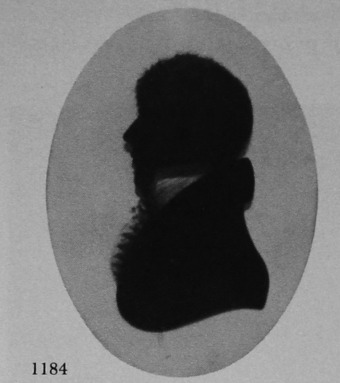
J. T. Rose, of Oxford
Silhouette painted on convex glass
23 March 1803
3 1/8 x 2 3/8 in./80 x 61mm.
Trade Label No. 1, printed in blue
The sitter was an organ-builder.
P. G. Higgs collection
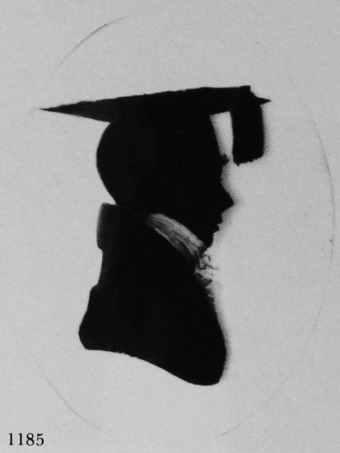
Unknown undergraduate of Oxford University
Silhouette painted on convex glass
c. 1804-1806
3 ¼ x 2 3/8 in./83 x 61mm.
Trade Label No. 1, printed in pale red
T. E. F. Sainsbury collection
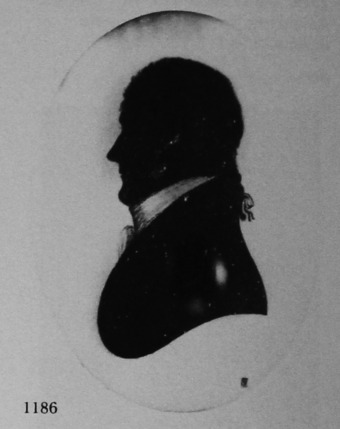
Unknown man
Silhouette painted on convex glass
c. 1805
3 ¼ x 2 3/8 in./83 x 61mm.
Trade Label No. 1, printed in blue
Author’s collection
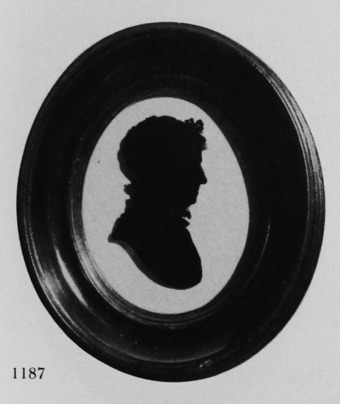
Mrs Anne Tongue
Silhouette painted on convex glass
c. 1805
3 ¼ x 2 5/8 in./83 x 67mm.
Mr Tongue, widow of Alderman Tongue, of Oxford, died in 1819 at the age of ninety-two.
P. G. Higgs collection
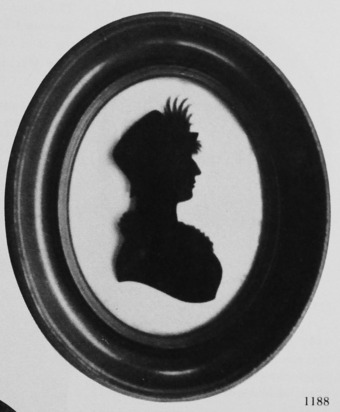
Mrs Arthur Annesley, of Blletchington Park, Oxfordshire
Silhouette painted on convex glass
c. 1810-12
3 ¼ x 2 3/8 in./83 x 61mm.
Trade Label No. 1, printed in blue
By courtesy of W. A. P. Wykeham
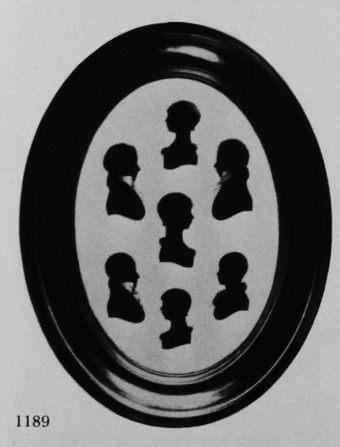
The Drake family
Group of silhouette painted on convex glass
c. 1810-12
5 ½ x 3 ¾ in./140 x 96mm.
Frame: pearwood
The members of the family depicted were collateral descendants of Sir Francis Drake, from his brother Thomas.
From Weymer Mills, ‘One Hundred Silhouettes from the Wellesley Collection’ (1912), by courtesy of the Oxford University Press
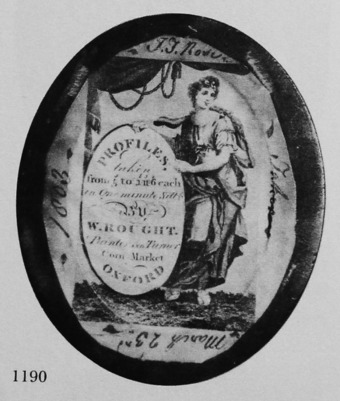
Trade Label No. 1 of William Rought, printed in blue (compare with the trade label of I. (or J.) Berry, q. v.). From the silhouette illustrated in 1184.
P. G. Higgs collection
DETAIL
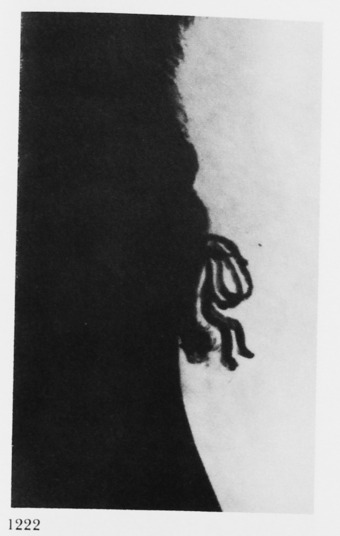
Pigtail wig. Detail from a silhouette of a man by William Rought.
The ribbons are rendered in a thin and spidery fashion. (1186)
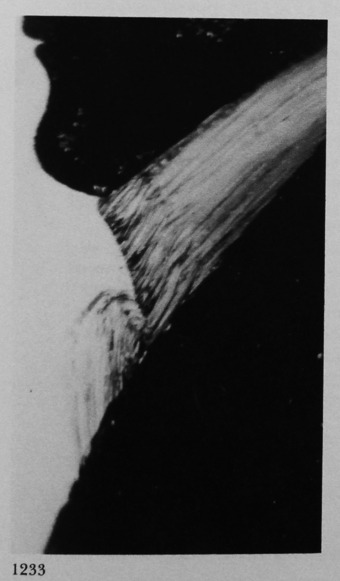
Shirt-frill. Detail from a silhouette by William Rought. The artist appears to have used a needle near the front of the cravat. (1186)
